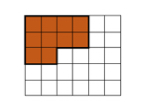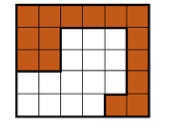General Information
Benchmark Instructional Guide
Connecting Benchmarks/Horizontal Alignment
Terms from the K-12 Glossary
- Rectangle
Vertical Alignment
Previous Benchmarks
Next Benchmarks
Purpose and Instructional Strategies
The purpose of this benchmark is to build understanding that figures can be partitioned in multiple ways, the parts can look different but they still represent an equal amount of the whole.- Instruction includes the use of manipulatives including geoboards, fraction circles, pattern blocks or color tiles.
- Instruction includes the idea of part-whole relationship if supported by a model.
- Students are not expected to use formal fraction notation until grade 3.
Common Misconceptions or Errors
- Students may have difficulty partitioning into equal-sized parts.
- Students may not understand that the parts can be equal parts even if they do not look identical.
Strategies to Support Tiered Instruction
- Instruction includes geoboards to partition rectangles and circles into thirds.
- Instruction includes graph paper to divide shapes into equal parts when given part of a
whole by counting the units inside the shape.
- For example, the shape is a total of 30 units and one equal part is given. Students partition the shape into 3 equal parts using the knowledge that one part is equal to 10 units.

- Teacher provides opportunities to use fraction manipulatives to develop understanding of thirds in circles and rectangles.
- For example, teacher provides pictures of circles and rectangles (of the same size as the manipulatives) on a sheet of paper. Students then use the “thirds” manipulatives to trace the thirds into the circles and rectangles, so they develop an understanding of how to partition these shapes into thirds.
- Teacher provides opportunities to use a pre-partitioned shape on graph paper to count units and determine if the different sized parts are equal.
- For example, the shape is partitioned into two parts. Students may count to determine if they are equal parts.

Instructional Tasks
Instructional Task 1 (MTR.2.1)
Provide students with multiple copies of a three-unit by four-unit array.- Part A. Shade the array to show how it can be partitioned into two, three and four equal- sized pieces in as many ways as possible.
- Part B. Discuss with a partner or in a group why the parts look different but still represent the same equal-sized part of the whole.
Instructional Task 2 (MTR.4.1)
Given the images below, discuss why these are divided into three equal parts.
Instructional Items
Instructional Item 1
Four friends will share a large rectangular pizza. Show several ways they can cut the pizza to show four equal-sized pieces.*The strategies, tasks and items included in the B1G-M are examples and should not be considered comprehensive.
